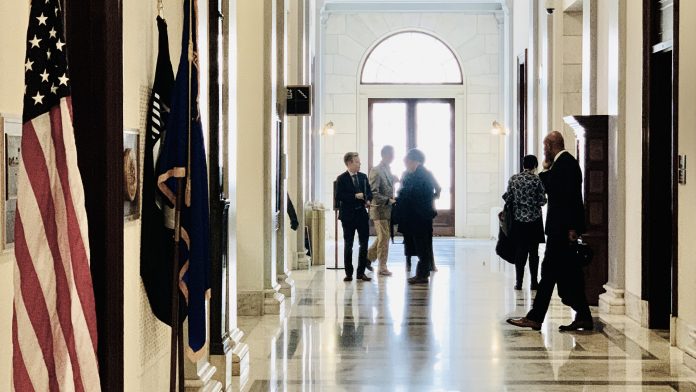American Diversified Enterprises outlines how lobbying is essential to influencing government policies concerning sustainability and the bioeconomy.
Everyone with an interest in advancing sustainability, innovation, and the bioeconomy – entrepreneurs, visionaries, project developers, suppliers, and local communities – should be aware of, keep track of, and speak up on public policy issues that impact these interests.
This goes for all issues related to the bioeconomy. Some groups advocate aggressively for a single issue, such as expedited permitting or renewal of a tax credit but are missing in action on other issues. National government support (and local government support) is made up of a network of programmes, incentives, and funding opportunities.
Lose one, and opponents to these programmes become emboldened. They step up attacks on other programmes, and support for advancing innovations begins to weaken through a process of attrition.
This is a bottom-line issue
It’s a jobs issue. It’s also a local tax revenue and economic development issue. And it’s a global competitive issue.
A single change to an existing public policy, for example, adding or removing an economic incentive, tax deduction, production credit, accelerated depreciation, research and development or incubator programme, grant, or low-interest loan guarantee — can create or eliminate markets, turn a profitable product into a loser, and launch or kill a promising project.
Changes in public policy also affect:
- Investment decisions;
- The risk profiles of bioeconomy and new, first-of-a-kind projects;
- The ability of these projects to secure financing; and
- The costs of debt service.
I am a registered lobbyist who has lobbied on and off for 40 years at the US local, state, and federal levels on issues affecting agriculture, energy, the environment, and the bioeconomy.
I often am stunned by how few companies and, in particular, how few communities that can benefit from bioeconomy projects, give adequate attention to the regulatory and funding changes, threats, and opportunities that arise in each legislative session.
Involvement is vital
The purpose of this article is to explain why your involvement is important. Another purpose is to provide tips on how you can become an effective advocate for sustainability, the bioeconomy, and the advancement of innovations at each policy level of government.
My lobbying experience covers town and city councils, county supervisors, state legislators, and the US Congress. But it is applicable to all levels of government in other countries as well; the same basic tenets apply in almost all cases.
Some of the references below may use terms that are US-specific; they are meant to apply as well to their counterpart terms in other countries.
Here’s why it is important to speak up
In early 2017, with a new administration in Washington, DC, there were clear signs that many federal government activities that favour renewable fuels and power, electric vehicles, new technologies to reduce the reliance on fossil-based fuels and products, and anything ‘green tech’, were not popular and were under attack.
Few US Congressional offices and virtually none of the Members of Congress who serve on the appropriations committees heard an outcry, or anything more than a whisper, from constituents and companies that would be affected by changes in these policies.

Within the bioeconomy industry, virtually everyone was focused on one or two issues of their own and thought that someone else was speaking up for the rest.
There was, therefore, no outcry. No constituents swamping Congressional phone lines to voice their opinions. No requests for meetings with staff.
This inaction on the programmes under threat sent a clear signal. They were not a priority. No one cared if they stayed or went. Hence, their funding could be better spent elsewhere.
I, too, had been sitting on the sidelines
I had been inactive as a lobbyist for some time. Because one party had become ‘the party of no’ during the previous Administration, very little legislation had moved forward.
I assumed – as many other company CEOs must have been doing – that someone certainly was watching what was going on and was doing something about it.
I was wrong.
The first step in setting federal funding levels for each fiscal year is passage by the House of Representatives of its version of the 12 appropriations bills that fund the US government.
The House-passed appropriations bills in 2017 were a clarion call.
A $40bn programme for the construction of projects using new, innovative, game-changing technologies was on the chopping block. So was the staffing and funding for another 50+ federal programs supporting the bioeconomy, with their funding being reduced by more than half, from over $80bn to less than $40bn.
I quickly rallied and began meeting with Congressional staff, just as the August recess was beginning. I learned that, in far too many cases, I was the first person to visit their offices to discuss several programmes or only the second or third person who had taken time to explain their value and the impact their loss would have on national and local economies.
This was six months after the annual appropriations process had started.
A group of another 20 lobbyists and attorneys, who regularly work on federal agency issues, also banded together in an ad hoc coalition to reach out to these offices. They heard the same thing:
- “We polled all of the Senate/House offices prior to starting work on the appropriations bills, and none of the offices mentioned this as a priority.”
- “We haven’t heard from anyone else on this.”
- “You’re only the second person this year to come in to talk to me about this.”
What could be done, with time running out?
Most years, Congress is unable to complete work on its appropriations bills before the federal government’s funding runs out on September 30 at the end of the fiscal year. To keep the government running, Congress passes a series of short-term ‘continuing resolutions’ (CRs) to bridge the funding gap until the appropriations bills can be consolidated, voted out of Congress, and sent to the President for signature and enactment.
CRs continue the prior year’s funding levels for government agencies and programmes until the new appropriations bills can be enacted.
Had it not been for the inability of Congress to complete its work on setting federal funding levels for 2018 after the 2017 fiscal year funding ran out, necessitating multiple CRs, many of these programmes could have been lost.
The delays by Congress provided the time necessary for the affected companies, project developers, and industry groups to rally, speak up, and, after a struggle, avert the cuts.
The bioeconomy: Lessons to be learned
Every person’s voice is important. Each person who reaches out to his or her policymakers can make a difference. Assuming someone else will do it is a mistake.
The more people who reach out, fill out policymaker online forms, send emails, place calls, and take the time to craft well-thought-out, easy-to-understand letters of one-and-one-half to two pages in length with compelling, well-documented arguments, signed by multiple companies, industry groups, and constituents, the better.
My purpose in writing this article is to help you avoid close calls with upcoming public policy issues, counter threats to the programs that advance innovation, and advocate for the expansion of these programmes and their funding.
Threats to the bioeconomy are ongoing
Several programmes and funding supporting the bioeconomy are under continual attack at all levels of government, from opposing and competing interests. These programs:
- Stimulate innovation;
- Support research;
- Provide an initial boost to new entries in the marketplace; and
- Support advancements in new technologies, innovation, and the bioeconomy.
There are many competing and opposing interests that are well-established, well-funded, and well-connected. This opposition can be met head-on, and, if not overcome, at least mitigated.
Every person can make a difference who speaks up to support public policies that will have a positive effect and speak out against policies that will have a negative effect.
Your effectiveness, and your ability to get your message across, however, depends upon how you do it.
What’s the best way to have an impact?
I can be much more effective if I walk into a meeting to discuss a subject that has become a hot issue, or that policymakers and their staff have been hearing about. You can be much more effective in those circumstances as well.
It is much harder – and often impossible – to make a difference when you are the only person trying to raise an issue, especially if there are campaign donors, company executives, other lobbyists, and policymakers across the hall trying to tear it apart.
Encouraging others to reach out and generate calls and letters are key parts of any legislative strategy.
Are protests effective?
The people who participate in protests are motivated, passionate, and enthused by the opportunity to engage in something bigger than they are, something tangible, that allows them to join in with others to express a concern.
Protests are meant to be large and, while usually peaceful, are purposely disruptive so they can attract media coverage to focus attention on an issue. Unfortunately, media outlets are often more interested in crowd size, rather than what is chanted or written on signs. Therefore, size is what likely will feature most prominently in their reports.

The problem with protests is that their message too often is: “Here’s a problem, we’re unhappy about it, fix it.” Rarely, if ever, do they address how a fix is to be made.
And rarely do they have an impact on policymakers, except as an annoyance in having to fight snarled traffic to get home, getting pestered by reporters asking, “What are you going to do about it?” and having to speak over loud chants as protesters parade past their offices.
Policy changes take a lot more than a chant or a few words on a sign. The same passion, motivation, and number of people can, therefore, have a much greater impact if everyone simply stays home and spends their time placing calls, filling out online forms, and writing emails and letters to policymakers that not only state the problem they see but suggest what can be done to fix it.
This is where lobbying comes in.
Here’s how to be effective
Lobbying involves education, psychology (i.e., understanding each and every policymaker you approach, and using that understanding to communicate effectively), networking, ally- and relationship-building, creating a bulletproof case built on a solid foundation of verifiable data, and making well-reasoned, easily understood, compelling arguments for policies that will have a positive effect and against policies that will have a negative effect.
When organising a lobbying campaign, you need to ensure that everyone you ask to participate has a key message to communicate, a fix to suggest (which may be simply urging a policymaker to vote yes or no on an upcoming bill), and several one-sentence talking points.
You must stress, emphatically, that participants be polite and respectful in their communications. Anyone who is disrespectful, rants, goes on and on, or uses foul language will reflect badly on the entire campaign.
Participants also need to be organised in separate advocacy groups, based upon where they live. Policymakers listen to constituents; those are the people who vote for them. People who are not constituents don’t count. Same for companies and businesses; if they are located in a policymaker’s district, the policymaker will listen; otherwise, not.
Advocacy organisations that represent constituents and home district companies can have considerable sway, since they speak with many voices for many voters, and are likely to already have established working relationships with policymakers.
It is important for campaign organisers to provide a short list of key points to cover, along with the office addresses, email addresses, and phone numbers of the policymakers to contact. Rote messages need to be avoided. They shout, “organised campaign.” Consequently, the communications likely will be labelled as coming from a single source. It is important, therefore, to stress to participants that they need to take the talking points provided and put them into their own words in letters and emails.
The one exception to this is phone calls: participants should be given a short script that takes 30 seconds, no more, to state support or opposition to an issue.
Policymakers’ offices track the issues being raised and the number of pro and con calls and emails received. This is reported to the policymaker, sometimes daily, sometimes weekly. This input is taken into consideration in the decisions made, strategies implemented, policy statements drafted, and legislation crafted. The best arguments are those that avoid partisanship and ideology and demonstrate how jobs, wages, and the bioeconomy of each community will be impacted in a policymaker’s backyard where the people who vote for him or her live and work.
Because each policymaker is different, with different motivations, backgrounds, and objectives, communications need to be flexible and adaptive enough to tie in and speak to these interests. Knowing how to, and how not to do this is a vital key to success.





